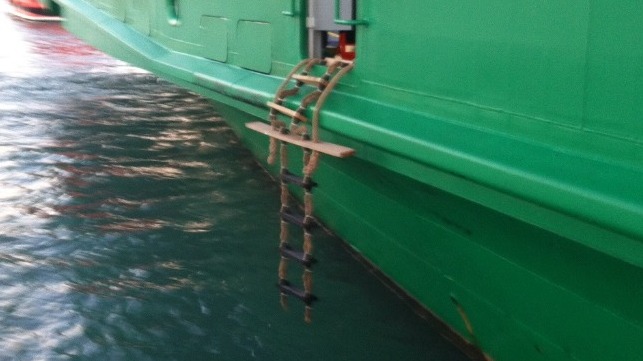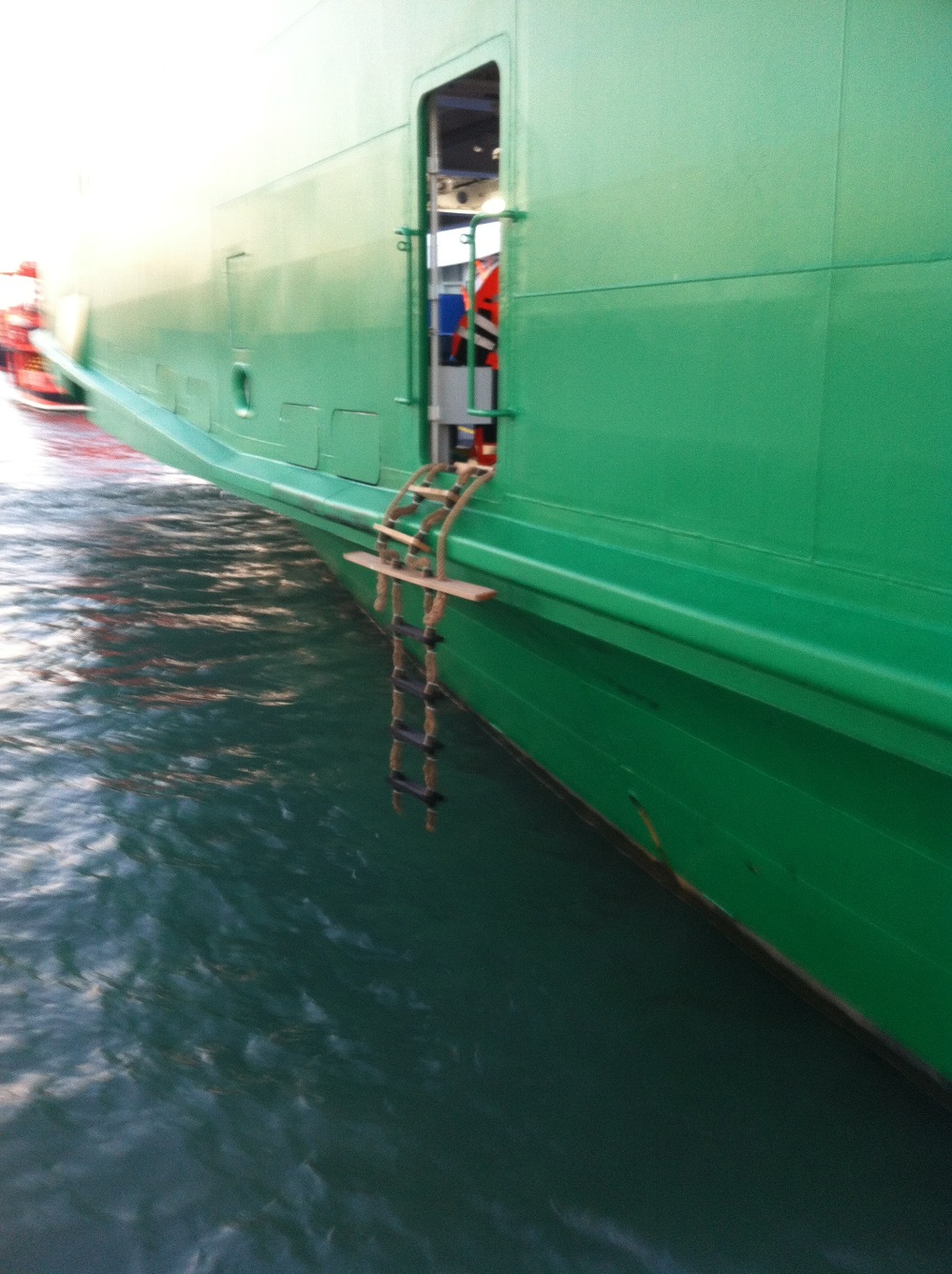Common Pitfalls for Pilot Transfer Arrangements

Pilot ladders are the most effective way for most marine pilots to embark and disembark at sea, provided the regulations are complied with and risks are properly assessed. Unfortunately there continue to be tragic accidents with loss of life.
To enable ships' crews to properly and safely rig a pilot ladder, it is important that the vessel is properly designed and built with pilot transfer arrangements given the consideration they deserve. All too frequently pilots encounter situations where poorly designed pilot transfer arrangements are non-compliant with the regulations.
Over the last century the IMO SOLAS Convention has been continually expanded to cover all aspects of ship safety, including requirements for pilot transfer arrangements. The standard it sets out is the minimum required to maintain a safe working environment for pilots during transfer operations, avoiding unnecessary risks to life and limb.
Under Resolution A 1045 (27), the first recommendation is that ‘ship designers are encouraged to consider all aspects of pilot transfer arrangements at an early stage in design’. Here are the requirements of SOLAS V Regulation 23, along with some common examples of non-compliance.
"3.3 Safe and convenient access to and egress from, the ship shall be provided by either:
.1 a pilot ladder requiring a climb of not less than 1.5 m and not more than 9 metres above the surface of the water so positioned and secured that:
.1 it is clear of any possible discharges from the ship:"
Figure 1 clearly shows an overboard discharge which would go directly onto the pilot launch.
".2 it is within the parallel body length of the ship and, as far as practicable, within the mid-ship half length of the ship:"
The arrangement shown in figure 2 is very dangerous for the pilot launch. When pilot ladders are rigged so far aft it can lead to the launch being sucked under the cutaway quarter. Note also the overboard scupper just aft of the pilot ladder.
".3 each step rests firmly against the ship’s side; where constructional features, such as rubbing bands would prevent the implementation of this provision, special arrangements shall, to the satisfaction of the Administration be made to ensure that persons are able to embark and disembark safely;"

Figure 3. The steps of this pilot ladder cannot rest against the ship’s side.
The most recent amendment to SOLAS affecting pilot transfer arrangements came into effect in July 2015. One of the major ‘new’ requirements was the need for pilot transfer arrangement’s involving a combination ladder arrangement to be attached to the hull of the vessel. A combination ladder arrangement is required for vessels with freeboards of nine meters or more, and usually consists of a pilot ladder used in ‘combination’ with an accommodation ladder.
This is something which is relatively easy to achieve with either lashing points constructed into the hull of the vessel or by using securing magnets. What is sometimes not so easy to achieve is an accurate assessment of the freeboard height. This can have very serious consequences.
In September 1974, a UK pilot tragically lost his life when falling from the pilot ladder of a storm damaged passenger ferry he was endeavoring to take into shelter. On trying to get an acknowledgement of liability from the vessels owners, the pilot's widow lost her case and a subsequent appeal because the pilot was adjudged to have been partially responsible for the accident because he attempted to board a vessel with a freeboard of greater than nine meters without using a combination arrangement.
His colleagues were not surprisingly very concerned by this and came up with an ingenious (and very cheap) method of easily identifying freeboards of more than nine meters. The pilot-inspired solution was paint a white over red pilot flag on the ship side with the boundary between the colors marking nine meters of freeboard. If any of the red paint is visible, the freeboard exceeds nine meters and a combination ladder must be rigged for the pilot transfer operation. Although universally accepted at the time to be an inspired initiative, the mark has not been widely incorporated into ship designs.
[Figure 4 illustrates the IMPA recommended nine meters freeboard mark. Note also the six meter cutaway in the fender, obviously a ship designed with pilot safety in mind.]
One fairly recent innovation seen with pilot transfer arrangements is the use of what the regulations refer to as an ‘embarkation platform’. A typical embarkation platform is shown in figure 5. This type of arrangement is sometimes referred to as a ‘sloping ladder.'
Figure 5
An overwhelming majority of pilots have serious concerns about the use of such platforms due to the myriad of potential non-compliance encountered with such arrangements. For the arrangement in figure 5 these include:
-
The pilot ladder is not rigged to extend through the trapdoor and secured 1.5 meters above the bottom platform ( SOLAS 3.3.2.1). The method of securing the ladder to the underside of the platform shown in the figure is dangerous because the transition from the pilot ladder is done via an uneven step height.
-
The horizontal cross member to which the pilot ladder is secured is a distraction from using the side ropes when transitioning onto the pilot ladder when disembarking.
-
The pilot ladder steps cannot rest firmly against the ship's side, due to the nylon wheels attached on the inboard side of the bottom platform.
-
The ‘sloping ladder’ is not securely attached to the hull.
-
Inevitably the securing of the whole of these arrangements is made using the wires supporting the gangway. It must be remembered that any dynamic loads to the pilot ladder from contact with the pilot launch will also be transferred to the hoisting/supporting wires, something they are unlikely to have been certified for.
Most marine pilots work with a positive ‘can do’ attitude, which is one reason why so many vessels continue to operate with non-compliant pilot transfer arrangements. It cannot be overstressed that the examples given in the article are not single one-off instances; they are continually encountered around the world. CHIRP Maritime have in the first 4 months of this year received over 30 reports of this type.
To put it bluntly, ship designers, ship builders, flag state administrators and classification societies need to take a hard look and make sure that the pilot transfer arrangements for all vessels comply in all respects with SOLAS V Regulation 23 and IMO Resolution A 1045 (27).
Captain Kevin Vallance MNI is a licensed deep sea pilot and the author of the Pilot Ladder Manual, published by the Witherby Publishing Group.
The opinions expressed herein are the author's and not necessarily those of The Maritime Executive.
